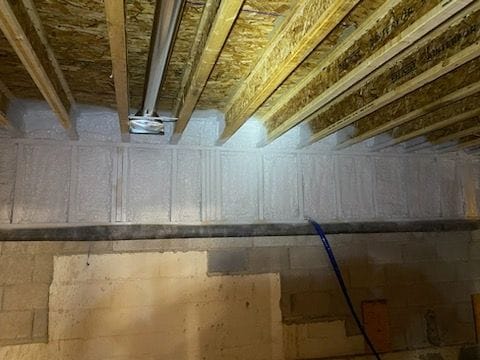Stevens Insulation Services offers our customers installation of a thermal barrier over the spray foam insulation using DC315 Intumescent paint.
Thermal Barrier
What is a Thermal Barrier
Spray foam insulation is a foam plastic that is a combustible material and is considered a risk for spreading flames. It is required by the International Building Code (IBC) to be separated from occupied building spaces by ½” gypsum board or a 15-minute thermal barrier.
A thermal barrier is a material applied between foamed plastics and interior spaces designed to:
1. Delay the ignition of the foamed plastic insulation in a fire
2. Delay or prevent the involvement of the foamed plastic in the fire
A 15-minute thermal barrier (a barrier that resists catching or spreading fire for 15 minutes after exposure) is normally constructed with materials like gypsum or fire-rated drywall.
Intumescent coatings like DC315 are considered to be alternative thermal barriers. It is specifically designed to impede the transfer of heat and is a quick, easy installation with a spray-applied coating that eliminates the need to build costly wood-framed assemblies using gypsum and is perfect for areas that will not be finished like crawlspaces or unfinished basements. Another advantage of using intumescent paint is its versatility. It can be applied to various surfaces and shapes, making it ideal for complex architectural designs where traditional thermal barriers like drywall may not be practical. Its seamless application ensures that even hard-to-reach areas are adequately protected, maintaining the integrity of the fire barrier throughout the structure. It can be tinted or painted over to meet with specific design requirements.
How Does Intumescent Paint Work?
Intumescent paint is designed to expand when exposed to high temperatures, creating an insulating char layer that slows the heat transfer and protects the underlying spray foam insulation. This unique property greatly enhances the fire resistance of the insulation, providing crucial extra minutes for occupants to evacuate the building in case of a fire.
NRC Canada
Paint to Protect

Basement Headers before Polyurethane spray foam applied and the Thermal Barrier

Thermal Barrier applied to Polyurethane spray foam in basement headers



